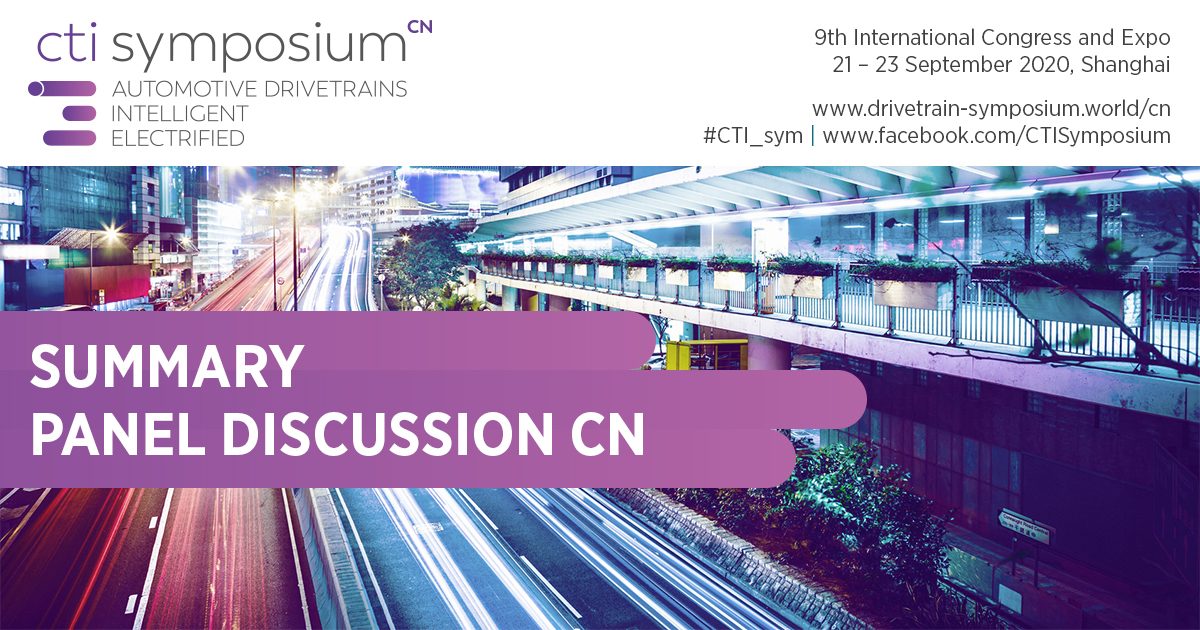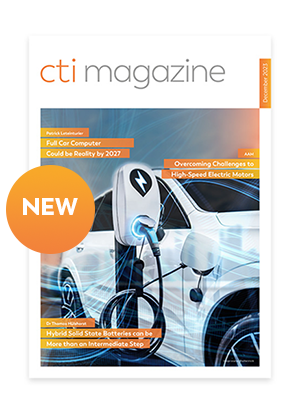
“Which powertrain characteristics and product strategies are important to have success on the Chinese market?”
Participants from left: Michael Schöffmann, Audi; Dr Shemin Zhang, Dongfeng; Ping Yu, Jing-Jin Electric; Prof. Tong Zhang, Tongji University; Prof. Ferit Küçükay, CTI Chair.
“Electric and combustion are not mutually exclusive”
While China leads the way in all-electric drives, big changes are coming soon. First, the ‘Energy Score’ target for larger manufacturers will rise in 2020 from 10 to 12, so they will need more electrification. Second, the far stricter ‘China 6a Emissions Standard’ takes effect in 2020. And third, China is slashing subsidies for EVs, which must then compete unaided in the market. So far, market response seems ti habe been negative; BEV sales have declined.
At this year’s CTI Symposium in Shanghai, these new challenges for the Chinese automotive industry featured strongly in the panel discussion. As usual, multiple topics were up for discussion and the audience participated via smartphone voting.
“What kind of drivetrain will be in your next private car?”
In response to this question, over 80 percent of the audience said their next car would still have an ICE, but as part of a hybrid drive; almost 20 percent would opt for a PHEV. Those figures were welcomed by Shemin Zhang, who still sees plenty of headroom for ICEs in terms of efficiency. Ping Yu was likewise not surprised, especially since pure BEVs still face big challenges such as costs, range, etc. He said SUVs were the main factor driving PHEV market share in China. Professor Ton Zhang put the results into perspective: “My next car could be an HEV or PHEV – but the one after that could already have a fuel cell.”
“What prevents you from buying a BEV?”
When Professor Küçükay asked the panel and audience this question, most people cited range, infrastructure and costs; charging times were considered less important. Prof. Zhang reminded listeners that while vehicle subsidies had been discontinued, infrastructure subsidies had not. He put the current ratio of charging stations-to-vehicles at 1:7, but said the real goal was 1:1. Schöffmann argued that OEMs could not build the infrastructure alone. Shemin Zhang agreed that BEVs were suitable for short journeys, car sharing, etc., but said it was also important to keep working on hybrid and conventional propulsion systems.
“Which type of vehicle will your company’s products mainly focus on?”
In reply, most company representatives said: “All drives, except fuel cell”. Michael Schöffmann pointed out that the market’s opacity meant companies basically had to pursue all forms of drives. For him, two key aspects were which sources of energy are available, and how efficiently they can be handled. Ping Yu likewise believes in diversity, but said ICEs would still play be a player. Prof. Zhang foresaw a bigger role for FCEVs in ten to fifteen years, while Shemin Zhang still saw significant challenges in terms of storage, transportation, etc., saying a great deal of research and development was still needed.
“How long will vehicles with a combustion engine be produced in China?”
Given such repeated support for ICEs, this was a logical next question to ask. A clear majority voted for 30 years, with 20 years coming in a strong second. Shemin Zhang said this reflected Dongfeng’s view that electric and ICE drives were not a case of ‘either or’. Nevertheless, Schöffmann predicted, increasingly strict legislation and falling battery prices would tip the scales in favour of BEVs. Prof. Küçükay asked about the outlook for 48V systems in China. Shemin Zhang said that had been a hot topic in China, but the cost-benefit ratio was so unfavourable that companies preferred to invest in improving ICEs instead. Ping Yu explained that while better power supply for ancillary units was also a factor in Europe, demand in China was low because the ‘small vehicles’ market was very cost-intensive. However, 48V might still get its chance for electric motors working further downstream, meaning in P2, P3 or P4 architectures, not P0. That would enable consumption savings of around 15 percent.
“In which areas do Chinese automotive companies need to catch up?”
In reply to this final question, most listeners chose ‘operating strategy’, followed by ‘internal combustion engine’. Prof. Zhang said several Chinese battery manufacturers ranked among the global Top Ten, so China was doing well in the field of electrification. Ping Yu put the gap in ICEs and operating strategies down to the fact that Europe had much longer experience in those fields. Shemin Zhang said China also needed to catch up in the transmission sector. Michael Schöffmann closed by saying Chinese suppliers had now virtually closed the gaps and were also very fast with software, particularly in the field of connectivity. Since software and connectivity are as important for tomorrow’s vehicle technology as electrification, that made an appropriate conclusion to the discussion.
